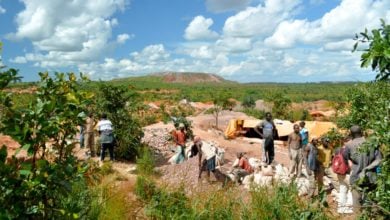Only one year after China suffered its worst earthquake in more than 30 years, the country stands poised to complete the reconstruction of large areas devastated by the catastrophe. Much of the reconstruction has been completed a year or more ahead of schedule.
|
This rapid rate of reconstruction stands in stark contrast to the recovery efforts by the U.S. government in the wake of Hurricane Katrina, still meager even nearly four years after the disaster.
As a result of the magnitude 8.0 earthquake that hit China on May 12, nearly 90,000 people died and hundreds of thousands of homes, schools, hospitals and factories were destroyed.
Immediately after the disaster, the country was in full mobilization. Within hours, 20,000 Chinese soldiers were deployed to some of the most difficult-to-access terrain in the world. Just days later, the Chinese government had dispatched 130,000 soldiers as well as civilian rescue teams, police and volunteers. According to the Washington Post, this rapid and widespread response was “a vivid demonstration of the Communist Party’s power to mobilize.”
Reconstruction efforts also began immediately after the disaster. Nearly 620,000 temporary housing units were speedily constructed just days after the quake struck.
Today, more than 21,000 post-earthquake recovery and reconstruction projects are underway in the affected provinces of Sichuan, Gansu and Shaanxi. Nearly 70 percent of China’s students have moved into new, permanent buildings and nearly 80 percent of new homes have been completed in the rural areas. Total government spending is estimated at 1 trillion Yuan, or $146.5 billion.
“My wife and I had prepared for the worst, to stay in prefabricated houses for three to five years,” said Wang Quan, from the village of Chaping just outside the city of Dujiangyan. Due to the speed of the reconstruction efforts, Wang and his wife were able to move into their new home far ahead of schedule. (BBC, May 11)
Prior to the earthquake, the walls of many buildings were not reinforced with steel nor properly secured to floors or ceilings, making the buildings highly vulnerable to collapse during and after the quake. According to China’s government, however, the new construction projects will greatly improve building standards.
Elizabeth Hausler, a U.S. engineer working in Sichuan, confirmed the government’s assessment. “It gives me a lot of hope because the central government is really trying to enforce building codes,” she said. (BBC, May 11)
New Orleans: a city in ruins
In stark contrast, one year after Hurricane Katrina ravaged the Gulf coast, New Orleans was still in ruins. Streets remained littered with debris; schools, hospitals and libraries remained closed;and hundreds of houses and apartment buildings were still boarded up.
Hundreds of thousands of former residents remained displaced from their homes, dispersed around the country. More than 250,000 were living in Texas, 100,000 in Georgia and 73,000 within miles of New Orleans in Louisiana.
Insurance companies were refusing to cover damages to property. Rents on apartments had increased by as much as 300 percent. The city’s education system remained only a shell of its former self. By July 2006, only 25 New Orleans schools had reopened, about 21 percent of the pre-Katrina figure.
In contrast to the Chinese government’s full-scale mobilizing efforts, it took five full days for U.S. military personnel to be dispatched to New Orleans in the immediate aftermath of Katrina. Residents attempting to reach safety were turned away at gunpoint by police, who were given shoot-to-kill orders to prevent alleged cases of “looting.” The widespread destruction itself was the result of government neglect and could have largely been prevented.
In subsequent years, the disaster has provided the perfect opportunity for private developers to implement long-held intentions to privatize public services such as education. Charter schools, which receive public funding while being privately run, have all but replaced public schools, while siphoning off vital funds from the remaining resource-strapped public institutions.
The Department of Housing and Urban Development has spent millions to bulldoze thousands of undamaged public housing units in order to “redevelop” the land for the benefit of private contractors. Prior to Katrina, HUD had systematically reduced the number of public housing units in New Orleans from 13,694 units in 1996, to 7,379 in 2005. Today, only 2,000 units of public housing remain in the entire city.
Indeed, the government’s reconstruction and recovery efforts, to the extent that they existed, were largely geared toward ridding New Orleans of much of its working-class Black population as part of a large-scale gentrification process.
Despite suffering a natural disaster of far greater scope and while possessing an economy significantly less developed than the United States, China has demonstrated a superior ability to provide for the needs of its people in the aftermath. It responded more quickly, dispatched more aid-related personnel and has since reconstructed more in one year than the United States has in the nearly four years since Hurricane Katrina.
What explains the stark contrast?
The answer lies in the fundamental differences between capitalism and socialism. The fundamental aim of capitalism is to maximize profit for the tiny capitalist class at the expense of workers’ needs. Socialism, on the other hand, is geared towards meeting people’s needs.
For the past three decades, increasing sectors of China’s economy have been transferred to capitalist forms of property. Private enterprise has developed, foreign corporations have gained access to the country’s economy and the commune system of collectivized agriculture has been dismantled.
However, in spite of the many capitalist reforms, socialist planning in China has not been fully eradicated. Public ownership of the means of production and central economic planning still exist, even if to a lesser degree than in the past.
Without these remaining elements of socialism, the government’s response to the catastrophe would have been all but impossible. The needs of capital would have taken precedence over the needs of people, as remains the case today in New Orleans.
As long as capitalism remains the dominant world system, responses to natural disasters will continue to fall woefully short of meeting the needs of countless victims everywhere. Only socialism can solve the contradictions of the capitalist system and provide for the needs of all people.







